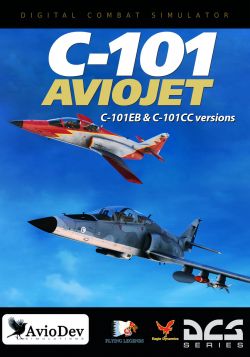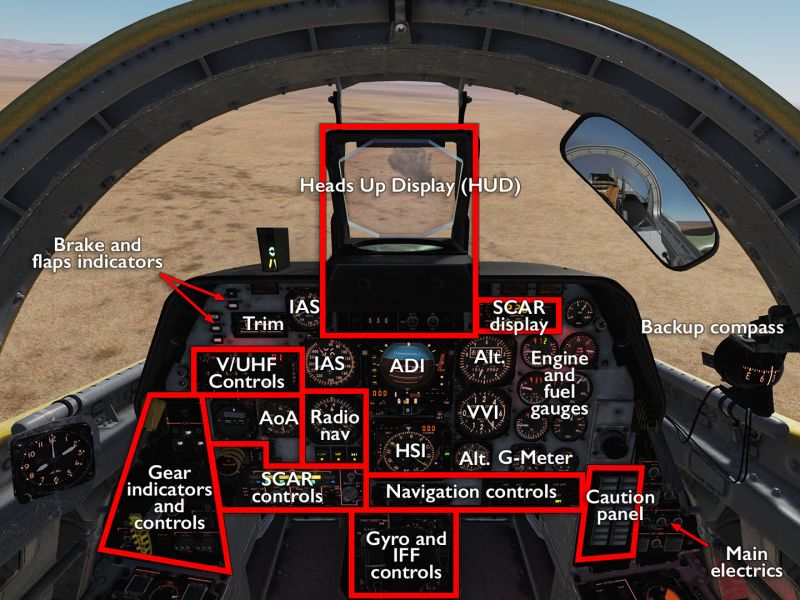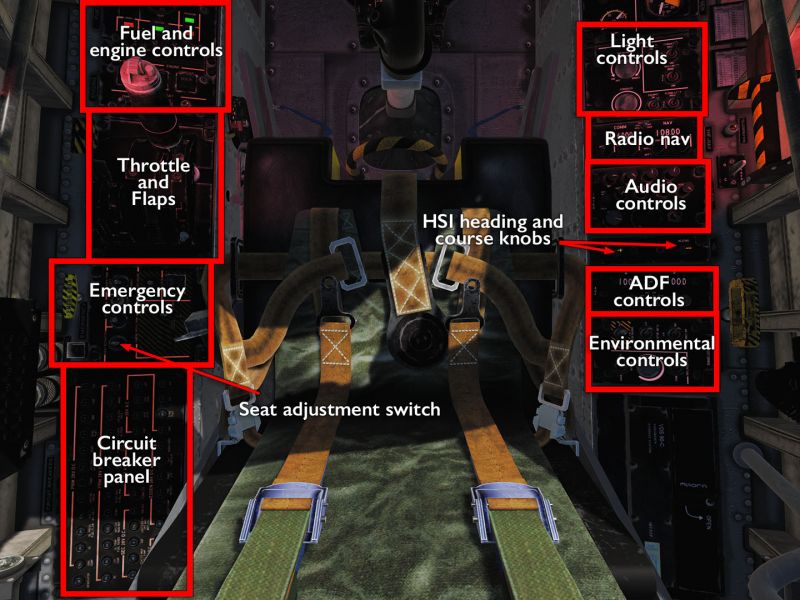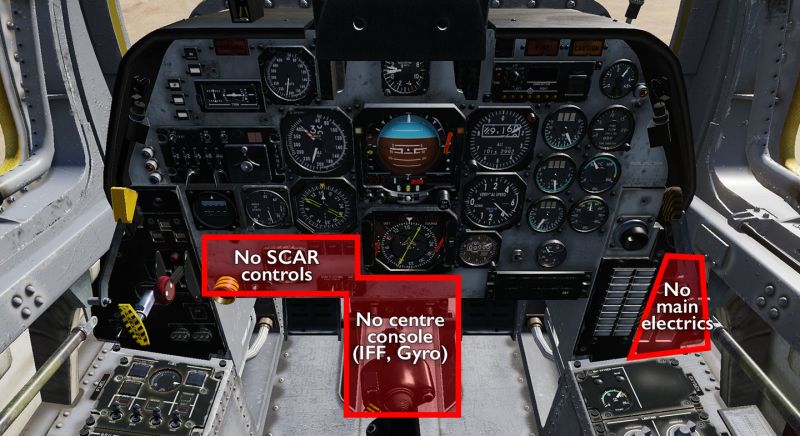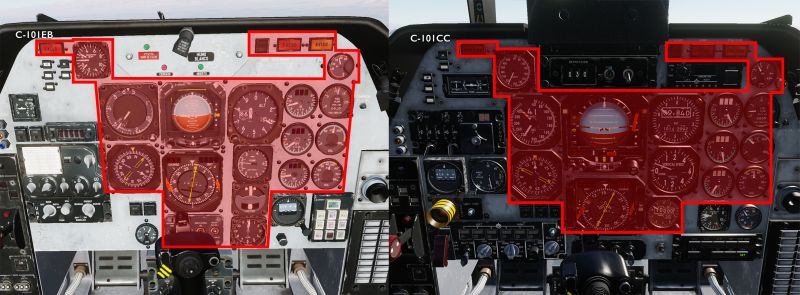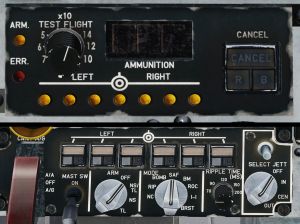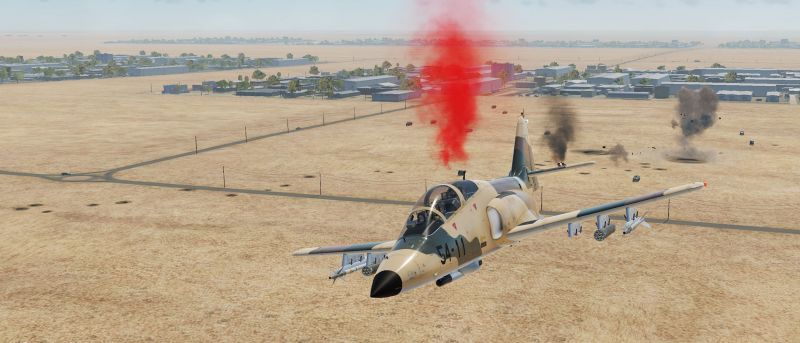C-101 Aviojet
| This is a beta module.
This module is still being developed and may still be missing some features and equipment options. It is playable and most of the content is there, but some final touches and fixes for minor bugs are still in the works. It is probably safe to buy unless you crave absolute fidelity and/or very few bugs. |
Ever had a hankering for a large, unswept, multi-crewed, ground- and sea attack training aircraft that would struggle in a straight-speed competition against the A-10? Well, good news: the C-101 is the module for you! In many ways, this is the Spanish take on the L-39: it is a relatively simple jet aircraft with room for a pilot and and rear-seat instructor, where the instructor can take over most of the flying if the pilot turns out to be a bad student, but can't really do the pilot's job as far as making things go boom.
The C-101 has been around in DCS for a long time, with a small team slowly whittling away at the problem and producing an unsteady stream of updates that at some point has congealed into something that has come to resemble a pretty good aircraft module. At times, so little seemed to happen that many feared the C-101 was headed into the same oblivion as the now-abandoned Hawk T.1A module, but Aviodev persevered and the pace has picked up considerably as of late.
Features
Much like the L-39, and for many of the same reasons, the C-101 features:
- The flight-training EB variant and the combat-training (and even to some extent combat capable) CC variant.
- Multi-crew: play as the front-seat pilot in training, or as overbearing back-seat instructor.
- Very little in the way of ordnance on the EB model, but a pretty wide selection on the CC model, including the reasonably competent Sea Eagle anti-ship missile.
- Differential breaking steering, because all trainees must suffer.
- A wide variety of radio navigation systems — TACAN, VOR, ILS, NDB, and plain old VHF directional finding — so you can learn how not to get lost.
- An automated flight director that might trick you into believing it is an autopilot, but where you have to do all the actual flying yourself.
- Some curious differences between the EB and the CC version that suggest some of the above are crutches you should learn to live without.
- A very, very lazy and underpowered engine. The IAS gauge tops out at 450kts — which is what you'll see when you you're pointed straight down — and you will only rarely see the needle go above 250.
Comes with the built-in campaign C-101s Over Georgia.
Missing features
The C-101 is not listed as “early access” in the DCS store, but don't let that fool you: this is still a module under development. As such, there are a few things that still need work from the developers:
- The multi-crew is still fairly rudimentary and prone to desync between the front and back seat.
- The flight model still needs a fair bit of tweaking.
- A final art polish pass — some of this is due to how long the module has been in development.
- A complete and fully indexed manual.
Flying the C-101CC
Overall, the C-101 is a fairly simple aircraft to fly. Its setup and controls layout offers very few surprises and it will give you plenty of warnings if you're trying to push it too hard. But that is also something you will recognise very quickly: it is not an agile speed demon, and it doesn't take much for the aircraft to feel that it is being pushed too hard.
Any kind of pull on the stick will set off the AoA warning, and it has neither the acceleration nor the top speed to simply power its way out of a bad situation. This holds doubly true in the CC model, where these base characteristics are not exactly improved by hanging all kinds of draggy and heavy ordnance under its wings.
Cockpit overview
The C-101 has a reasonably well designed cockpit, but it also suffers slightly from being a trainer. The EB model has all the controls and gauges that you'd want to see as you learn to fly the thing, but in the CC model, this translates into having very little left-over room for the extra weapon controls that the combat model needs. Some crowding and odd arrangements of seemingly related controls is the unavoidable consequence.
The back seat of the C-101 is for the most part the same as the front seat. What is missing is some of the combat-specific controls, such as the weapon selection and release systems, IFF systems, and the starting electrics. Presumably, if the instructor has to land the thing, you can just ask the ground crew to hoist out the trainee and then turn everything off from the now-vacated front seat.
As mentioned, the EB and CC models are mostly the same in terms of major instrument placement, but the need to add weapon controls to the CC meant that some things had to be shifted around. The above image shows the core instrument commonalities, where some specific gauges have moved around a little or changed design, but the general instrument scan is more or less the same. Of note is that the radio console has changed to make room for the SCAR (Selection and Control and Release) panel, and this is also a subtle hint at a more significant difference between the two: the EB model offers TACAN navigation; the CC model does not. The EB also has a much larger focus on the automated flight director, whereas it CC pilot is meant to make due with a reduced variant.
Getting into the air
Getting the C-101 going is not an overly complex procedure because it is, quite simply, not a very complex aircraft. As usual, there is the standardised RWinHome “cheat” hotkey to run the process for you, and it is fully described in the manual and in Chuck's guide linked below. The gist of it all is:
- Attach ground power and make sure the wheel chock are installed. Also check your parking brake.
- Slave the gyrocompass.
- Turn on your essentials: lights, oxygen, intercom and V/UHF radio.
- Turn on on-board electrics: battery, generators, inverters.
- Set up the engine computer, and turn on the fuel pumps.
- Press the start button and monitor everything to make sure the engine actually gets going.
- Disconnect ground power (the wheel chocks should be removed automatically by the ground crew during startup).
- Set up your flight instruments: ADI, IFF, altimeter.
- Set up flight electrics: stall warning, pitot hit, engine anti-ice.
- Close and lock the canopy, ask for permission to go be a nuisance somewhere else, and waddle off to the runway.
Shooting something
Weapon selection in the C-101CC is very reminiscent of what you would see in the classical A-10A: on the SCAR (Selection and Control and Release) controls you pick pylons using illuminated push-buttons that communicate the loading state of that pylon. You then set up firing signals — ordnance type, ripple amounts, ripple timing and the like — with a couple of dials, and then you check the SCAR display to see that the right type of firing signal will be sent.
Firing rockets
For rockets, the process is this:
- Switch Master Arm to ON.
- Ignore bomb ARM dial.
- Turn the weapon MODE dial to ROC (if carrying mixed bombs and rockets), 1-1 (to fire single rockets) or BRST (to fire a burst).
- If firing a burst, set a ripple time.
- On the SCAR display panel, make sure the ERR light is not lit; make sure the mode button's lower-left &squo;R’ light (for rocket mode) is lit — if not, push the mode button to cycle back to rocket mode.
- Back on the SCAR control panel, push the button for the pylons you want to fire.
The upper yellow light indicates the pylon has been selected; the lower-left green light indicates that stores are available; the lower-right ‘NS’ light indicates that no stores are carried. - Confirm that the corresponding pylon lights light up on the SCAR display panel.
- On the control stick, uncover the weapon release button.
You are now ready to struggle with the actual delivery of the rockets, which is nothing like what the good old 'hog offers. Instead, it is a matter of setting up the stadimetric rangefinding pipper on the HUD (i.e. you compare the apparent size of the target with a preset angle indicator — when the two match, the target is at the right range), and then delivering your weapons at the right speed and at the right angle from the right altitude according to extensive delivery tables in the manual or in Chuck's guide.
The gyro sight and the range finder, controlled by twisting the throttle, makes this setup reasonably simple, but it requires a steady hand and precision flying to be within the right parameters. Or you can just ignore the whole thing, set the sight to manual depression and dial in an angle you are comfortable with.
All other weapons follow a similar procedure, except with different settings on the ARM and MODE dials, and on the display mode button. The Sea Eagle missile, for instance, is for delivery purposes just a rocket with no need for any real aiming from the pilot.
Firing guns
If loaded in an under-slung pod, guns are always available as a secondary weapon that can be fired alongside and independent of the wing-carried stores. To get them up and running:
- Next to the SCAR control panel, flip up the red cover and move the fixed weapon switch to AA or AG, as needed.
- Make sure Master Arm is ON.
- Unblock the trigger on the control stick — a red flag will pop up to show the trigger is hot.
- Use the same kind of stadimetric (or manual depression) aiming as with rockets.
- Press the trigger when it seems like a good time to do so.
The SCAR display panel has a digital ammo counter that lets you keep track of how much you've sprayed lead all over the place to little effect.
Links and files
- Chuck's C-101 guide at Mudspike.
- DCS: C-101 Aviojet by AvioDev in the DCS shop.
Related DCS modules
- NS 430 Navigation system, and in particular the NS 430 Navigation System for C-101EB and C-101CC.
More information
- CASA C-101 on wikipedia.
- C-101 Aviojet on globalsecurity.org.



